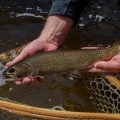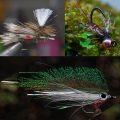In Search of Coasters
Five anglers. Five days. One mission.
Five Michigan anglers will embark August 31 for Isle Royale National Park in search of the fabled Coaster brook trout. Their aim? To catch and document these rare and enigmatic fish in order to draw attention to their plight.
Coasters historically numbered into the millions, but exploitation both commercially and by anglers, along with habitat degradation due to wholesale logging, have left only remnant populations. Isle Royale is one of the last strongholds of these fish.

I recently wrote a blog post titled “There’s No Such Thing as Coasters
,” because Coasters are not a special strain or sub-species of brook trout. They are genetically identical to all northern Great Lakes Basin brook trout, including stream resident fish. As it turns out, however, you can’t just stock the lakes and streams with brook trout and end up with Coasters. Coasters, scientifically referred to as adfluvial brook trout, are born in the streams, head down to lake Superior where they spend three years or more eating and growing, and then return to the streams to spawn.
They average about twenty inches long and three pounds but can grow as large as ten pounds, and the world record brook trout, a 14-pound 8-ounce behemoth (it likely weighed 20 pounds live as it was badly decomposed by the time it was officially weighed) came from the Nipigon river, home to a so-far thriving run of Coasters.
Why care about Coasters? Well, why care about greenback cutthroat trout? Why care about wild steelhead? Why care about the native fish of Bristol Bay? Coasters are unique, and scientists and researchers are only beginning to unravel the threads and understand what it is that makes the Coaster form of brook trout different from your average stream brookie. Understanding how to restore them is proving to be more of a conundrum. If they were a subspecies this might be easy—just breed and stock them—but instead biologists find themselves trying to understand how to turn on a biological mechanism and create an entire breeding strategy.
A big part of the answer may be in angler education and changing cultural attitudes. In a region where much of the recreational angling is still for subsistence, it is hard to make anglers understand why they should throw back an 18-inch fish or not keep every single one they catch. In the 1800s the sales pitch to sports coming north from the cities was that these fish were very easy to catch. Coasters are notoriously aggressive, which was their downfall in the first place. Historical evidence suggests that excessive harvest much more than habitat degradation led to their current state.
But the excesses and destruction of the past are largely over. Lake Superior continues to be a pristine environment. Forests and streams have recovered. The only elements missing are angler cooperation, a better understanding of what it takes to restore these fish, and a bit of will on the part of state and federal agencies. There’s no reason these fish can’t be brought back from being a whispered-about legend to having at least a moderately fishable status. The states of Minnesota, Wisconsin and Michigan have imposed 20-inch, single-fish limits on their Superior coasts, and Ontario requires them to be 22.5 inches with a single-fish limit. Ontario’s limits have resulted in Coasters once again being a common occurrence rather than a lifetime catch. With a little work, the same could be true on Lake Superior’s south and west shores.
So five anglers—Michigan author Wayne Snyder, Chris Reister, Bret Watson, Bob Miller and I—are headed to Isle Royale in search of these fish. Regardless of whether we catch fish or not we hope to draw attention to their plight and hopefully influence state and federal agencies to step up to restore these, our native fish. If you’re interested in the restoration of native fish you can help by following our progress at https://www.facebook.com/IsleRoyaleCoasters. We’ll be posting pictures and progress of the trip. We will also be posting information afterward of our findings, and what anglers can do to help restore this charismatic fish.
Good News: More Kids Fishing
NB Liquor Sales to Support Atlantic Salmon











